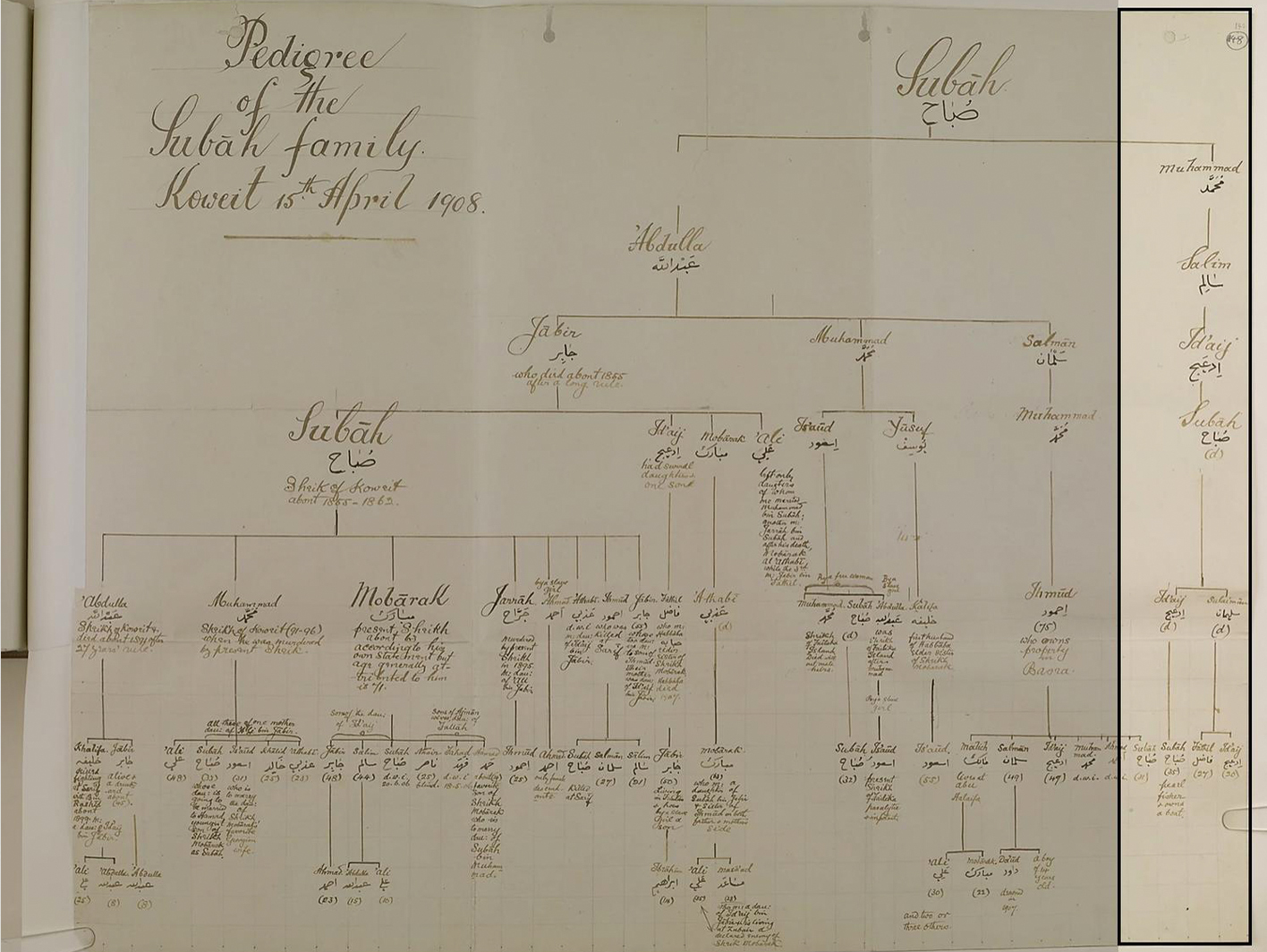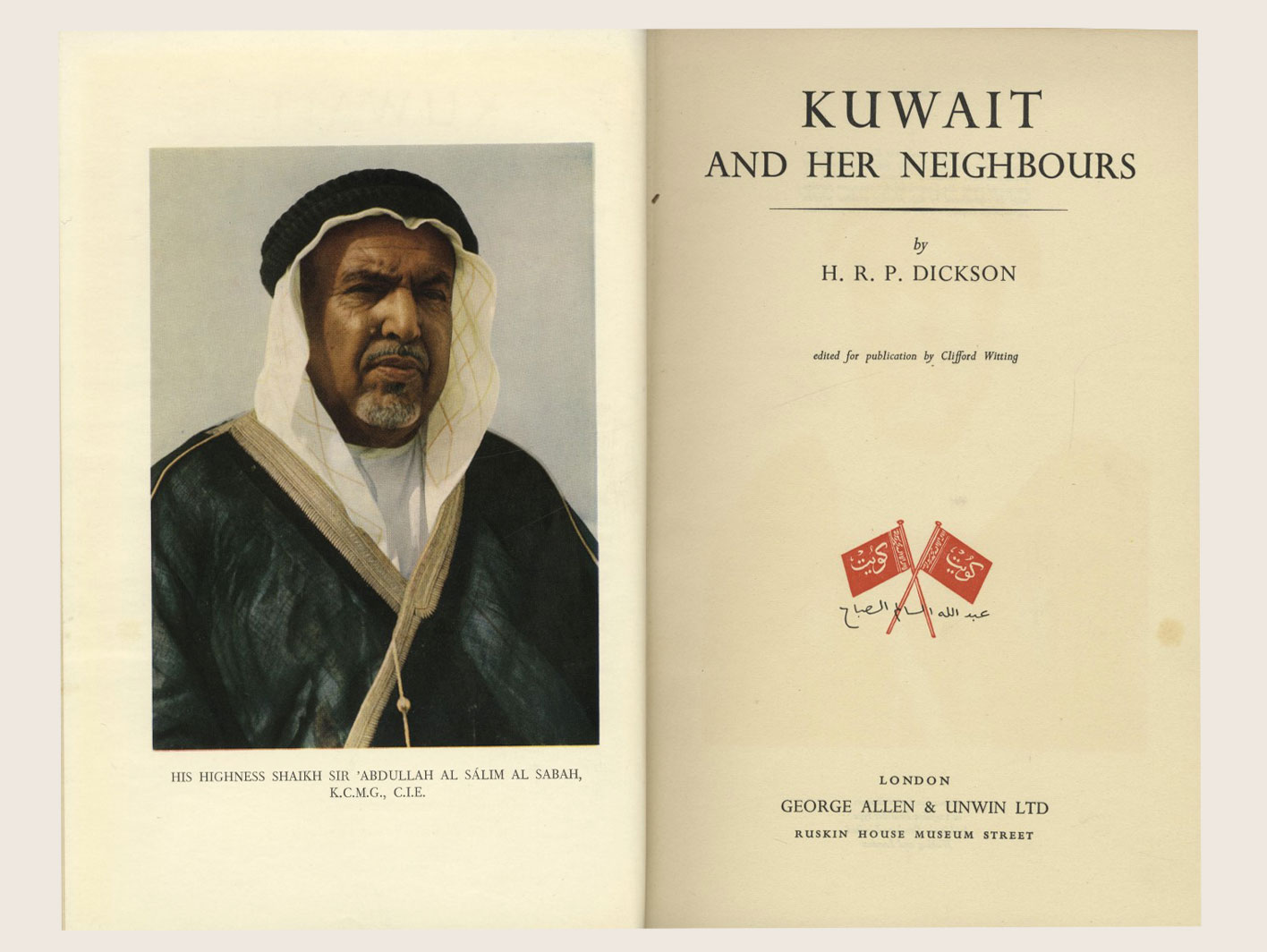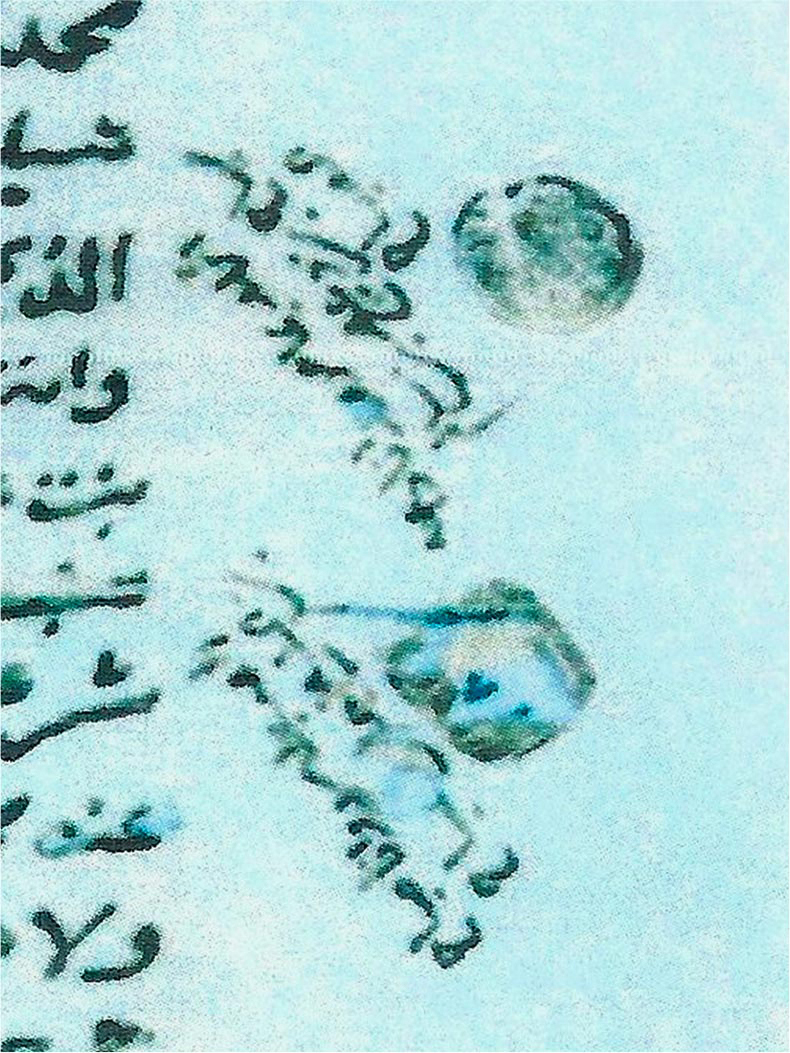Lineage of Salem Mubarak Sabah the First






Eight generations:
Mubarak Sabah the First to Shaikh Duaij Salman Al Sabah

Shaikh Mubarak bin Sabah the First


Mubarak was the third son of Sabah the First. He is mentioned in a report dated 1756 by Baron Tiddo van Kniphausen, A Description of the Persian Gulf and its Inhabitants in 1756: The highest ranking shaikh is Mobarak Eben Saback [Mubarak bin Sabah], but because he is poor and still young, another, called Mahometh Eben Khalifa [Muhammad bin Khalifah], who is rich and possesses many vessels, enjoys almost equal respect among them.1
According to Rush, the Kniphausen document suggests that Mubarak Sabah the First likely ruled following his father’s abdication or death, perhaps in partnership with his brother, His Highness former Emir Abdullah Al Sabah.
The Kniphausen report implies that Sabah the First ruled earlier than is generally believed, that he abdicated or died in or before 1756, and that leadership then passed to two of his sons – Mubarak and Abdullah. It seems that Mubarak did not rule alone since, if he had done so, this would not have been forgotten. It is reasonable to assume that Sabah the First relied on Mubarak as well as Abdallah in his final years and that, as a respectful younger brother, Abdallah also consulted him.2
Shaikh Abdallah Khalid Al Khalifa of Bahrain, the former Minister of Justice and Islamic Affairs, who created Bahrain’s National History Documentation Centre, also believes that Mubarak succeeded his father, although only ruled for a short time: I believe that Sabah the First died before the year 1170 AH [1756-57 AD] and was succeeded by his son, Mubarak bin Sabah; and that after Mubarak’s death in about 1171 AH [1757-58 AD], his brother, Shaikh Abdallah bin Sabah, became the ruler.3 Shaikh Abdullah later confirmed his view that the descendants of Salim Mubarak Al Sabah are members of the ruling family.
According to Rush, the Kniphausen document suggests that Mubarak Sabah the First likely ruled following his father’s abdication or death, perhaps in partnership with his brother, His Highness former Emir Abdullah Al Sabah.
The Kniphausen report implies that Sabah the First ruled earlier than is generally believed, that he abdicated or died in or before 1756, and that leadership then passed to two of his sons – Mubarak and Abdullah. It seems that Mubarak did not rule alone since, if he had done so, this would not have been forgotten. It is reasonable to assume that Sabah the First relied on Mubarak as well as Abdallah in his final years and that, as a respectful younger brother, Abdallah also consulted him.2
Shaikh Abdallah Khalid Al Khalifa of Bahrain, the former Minister of Justice and Islamic Affairs, who created Bahrain’s National History Documentation Centre, also believes that Mubarak succeeded his father, although only ruled for a short time: I believe that Sabah the First died before the year 1170 AH [1756-57 AD] and was succeeded by his son, Mubarak bin Sabah; and that after Mubarak’s death in about 1171 AH [1757-58 AD], his brother, Shaikh Abdallah bin Sabah, became the ruler.3 Shaikh Abdullah later confirmed his view that the descendants of Salim Mubarak Al Sabah are members of the ruling family.

Shaikh Salim bin Mubarak bin Sabah the First

Except for Knox, who states that Salim’s father was Muhammad Sabah the First4, it is agreed that Salim’s father was Mubarak Sabah the First. He is mentioned as such in the Bombay report of 1854 and in the genealogical trees prepared in Kuwait by Shaikh Na’if Al Malik Al Sabah and by Mu’alim Ismail Kaddo5.
Salim bin Mubarak bin Sabah the First was one of the leaders in Kuwait’s first naval battle, the Battle of Al -Raqqa on 12 August 1783, against the Bani Ka’b.6 The battle was started by Salim’s daring initiative to attack enemy vessels. His Highness the former Emir Abdulah Al Sabah opposed an attempt by Shaikh Barakat of the Nassar clan of the Bani Ka’b to marry his only daughter. Mariam. Following the battle, Salim married Mariam bint Abdullah I, his first cousin.
The story is recounted by Lt Col Harold Dickson, the Political Agent in Kuwait from 1929-36 in his book, Kuwait and Her Neighbours. The story was told to him by His Highness former Emir Abdullah Salim Al Sabah.
… on the reported approach of the enemy the beautiful Mariam was regularly to be seen – armed with pistol, sword and spear, and riding a mare – going the rounds of the early city defences and encouraging the Badu in their tents. How her young cousin Salim ibn Muhammad Al Sabah [Salim bin Muburak] and his gallant band met the armada widely scattered and becalmed by night south of the island of Bubiyan and, in the guise of simple fisher-folk, boarded five great dhows one after the other, silently put the sentries to the sword, battened the remainder of the crew between decks, brought the prizes back to Kuwait and presented them to Mariam must be recorded in another place. Suffice it to say that after this initial success and inspired by the burning enthusiasm of Mariam, young Salim … sped out to sea, engaged the remainder of the Bani Ka’b ships and put them to ignominious flight … From that day to this no Sabah princess has ever been allowed to marry outside the family.7
Salim bin Mubarak bin Sabah the First was one of the leaders in Kuwait’s first naval battle, the Battle of Al -Raqqa on 12 August 1783, against the Bani Ka’b.6 The battle was started by Salim’s daring initiative to attack enemy vessels. His Highness the former Emir Abdulah Al Sabah opposed an attempt by Shaikh Barakat of the Nassar clan of the Bani Ka’b to marry his only daughter. Mariam. Following the battle, Salim married Mariam bint Abdullah I, his first cousin.
The story is recounted by Lt Col Harold Dickson, the Political Agent in Kuwait from 1929-36 in his book, Kuwait and Her Neighbours. The story was told to him by His Highness former Emir Abdullah Salim Al Sabah.
… on the reported approach of the enemy the beautiful Mariam was regularly to be seen – armed with pistol, sword and spear, and riding a mare – going the rounds of the early city defences and encouraging the Badu in their tents. How her young cousin Salim ibn Muhammad Al Sabah [Salim bin Muburak] and his gallant band met the armada widely scattered and becalmed by night south of the island of Bubiyan and, in the guise of simple fisher-folk, boarded five great dhows one after the other, silently put the sentries to the sword, battened the remainder of the crew between decks, brought the prizes back to Kuwait and presented them to Mariam must be recorded in another place. Suffice it to say that after this initial success and inspired by the burning enthusiasm of Mariam, young Salim … sped out to sea, engaged the remainder of the Bani Ka’b ships and put them to ignominious flight … From that day to this no Sabah princess has ever been allowed to marry outside the family.7

Shaikh Sabah bin Duaij bin Salem Al Sabah

Shaikh Sabah was the grandson of Salim, the hero of the Battle of Al-Raqqa. His name appears alongside that of His Highness the former Emir Sabah II as a witness in a judicial verdict (known as an Adsani court order8) dated 22 August 1846. The court judgment was a dispute among Al Sabah family members, hence why members of the Al Sabah family were chosen as witnesses. The head of the court was Judge Abdullah Mohammad Al Adasani.

Shaikh Salman bin Sabah bin Duaij Al Sabah
b c1840
In 1854, Captain Arnold Burrowes Kemball, Resident of the Persian Gulf, based in Bushire, drew up a report on Kuwait, published in Selections from the Records of the Bombay Government.9 Known as the Bombay report, he describes Salman bin Sabah bin Duaij Al Sabah as cousin of chief [Jaber I Al Sabah, the 3rd Emir of Kuwait], second degree, age fourteen years, meaning that he was born in 1840.

Shaikh Muhammad bin Salim bin Jarrah Salim Mubarak Al Sabah
Martyred in the battle of Sarif, 1901
Muhammad was the great grandson of Salim, the hero of the Battle of Al Raqqa. Both his father, Salim (b c1834), and grandfather, Jarrah (b c1804) are mentioned by Kemball in his Bombay Report in 1854.
In 1900, a crisis erupted between Kuwait and the Najd, ruled over by Ibn Rashid, the Emir of Ha’il. Both Mubarak and Ibn Rashid strived to be the undisputed leader in Arabia. In December 1900, Shaikh Mubarak Al Sabah advanced into Najd, having gathered an impressive army of Kuwaiti townspeople, Saudi loyalists, and bedouin from all the important eastern Arabian tribes. His aim was to tear away the southern part of the Rashidi dominions, notably ‘Anayza, Burayda, and Riyadh. Mubarak had moderate success, capturing these three towns (except for the besieged citadel in Riyadh). However, his forces were defeated at the Battle of Sarif (near Burayda) on 17 March 1901. Hundreds of Kuwaitis died in the battle, including a brother and one or two nephews of His Highness the former Emir Mubarak Al Sabah the Great, and some Al Sabah family members, one of whom was Shaikh Muhammad bin Salim Al Sabah. Muhammad bin Salim Al Sabah’s death in the battle was reported by Ali Bin Ghulum Rida, the British Political Agent to Kuwait at the time.10
In 1900, a crisis erupted between Kuwait and the Najd, ruled over by Ibn Rashid, the Emir of Ha’il. Both Mubarak and Ibn Rashid strived to be the undisputed leader in Arabia. In December 1900, Shaikh Mubarak Al Sabah advanced into Najd, having gathered an impressive army of Kuwaiti townspeople, Saudi loyalists, and bedouin from all the important eastern Arabian tribes. His aim was to tear away the southern part of the Rashidi dominions, notably ‘Anayza, Burayda, and Riyadh. Mubarak had moderate success, capturing these three towns (except for the besieged citadel in Riyadh). However, his forces were defeated at the Battle of Sarif (near Burayda) on 17 March 1901. Hundreds of Kuwaitis died in the battle, including a brother and one or two nephews of His Highness the former Emir Mubarak Al Sabah the Great, and some Al Sabah family members, one of whom was Shaikh Muhammad bin Salim Al Sabah. Muhammad bin Salim Al Sabah’s death in the battle was reported by Ali Bin Ghulum Rida, the British Political Agent to Kuwait at the time.10

Shaikh Sabah Al Suq bin Duaij Al Sabah
b. 1873

Sabah Al Suq was Commander of the Town Guard or market guards in Kuwait – effectively the security chief – from 1917-38. He maintained order on behalf of His Highnesses former Emirs Shaikh Salim Mubarak Al Sabah and Shaikh Ahmad Jabir Al Sabah.
There are many stories about Sabah Al Suq. The following comes from the Kuwait Times (4 November 2015):
A funny yet terrifying incident took place back in 1937 when an armed gang, or at least that was the people thought at the time, kept robbing houses. People used to hear gunshots at night and immediately lock their doors and windows and stay up all night to resist the robbers in case they were attacked by the gang that used to rob a different neighborhood every night.
People were terrified for a whole week, and news about the gang of robbers travelled fast as people kept telling stories about how the robbers robbed the so and so family in Merqab or climbed the walls of another in Qebla.People were in great distress and fear.
The security chief at the time was Shaikh Sabah Al Duaij Al Sabah who was publically known as ‘Sabah Al-Souk’ (Sabah of the Market). The man suspected his own guards and accordingly examined their rifles by an expert to see whether any had been used in recent shootings during the night. They were all proven innocent, but Sabah eventually managed to identify and arrest the gang.
It turned out that the gang comprised of a young man named ‘Mahdali’ who had an old shotgun and was assisted by another, a porter to carry the items he stole. They were both arrested and chained by the hands to be taken on a tour around the old souk so that people could see them and rest assured. Kids chased the suspects lane to lane shouting: “That is the thief, Mahdali…..he is chained by the hand.” Accordingly, like Kuwaitis used to name years after major incidents, 1937 was later known as the ‘Year of Mahdali.’
There are many stories about Sabah Al Suq. The following comes from the Kuwait Times (4 November 2015):
A funny yet terrifying incident took place back in 1937 when an armed gang, or at least that was the people thought at the time, kept robbing houses. People used to hear gunshots at night and immediately lock their doors and windows and stay up all night to resist the robbers in case they were attacked by the gang that used to rob a different neighborhood every night.
People were terrified for a whole week, and news about the gang of robbers travelled fast as people kept telling stories about how the robbers robbed the so and so family in Merqab or climbed the walls of another in Qebla.People were in great distress and fear.
The security chief at the time was Shaikh Sabah Al Duaij Al Sabah who was publically known as ‘Sabah Al-Souk’ (Sabah of the Market). The man suspected his own guards and accordingly examined their rifles by an expert to see whether any had been used in recent shootings during the night. They were all proven innocent, but Sabah eventually managed to identify and arrest the gang.
It turned out that the gang comprised of a young man named ‘Mahdali’ who had an old shotgun and was assisted by another, a porter to carry the items he stole. They were both arrested and chained by the hands to be taken on a tour around the old souk so that people could see them and rest assured. Kids chased the suspects lane to lane shouting: “That is the thief, Mahdali…..he is chained by the hand.” Accordingly, like Kuwaitis used to name years after major incidents, 1937 was later known as the ‘Year of Mahdali.’


